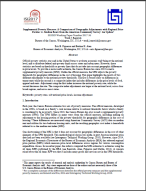
An official website of the United States government
Here’s how you know
Official websites use .gov
A .gov website belongs to an official government organization in the United States.
Secure .gov websites use HTTPS
A lock (
) or https:// means you’ve safely connected to the .gov website. Share sensitive information only on official, secure websites.
-
//
- Census.gov /
- Library /
- Census Working Papers /
- Geographic Adjustments with BEA RPPs vs. ACS Median Rents: An Update
Supplemental Poverty Measure: A Comparison of Geographic Adjustments with Regional Price Parities vs. Median Rents from the American Community Survey: An Update
Supplemental Poverty Measure: A Comparison of Geographic Adjustments with Regional Price Parities vs. Median Rents from the American Community Survey: An Update
Official poverty statistics are used in the United States to evaluate economic well-being at the national level, and to distribute federal anti-poverty funds across states and urban areas. However, these statistics are based on thresholds or poverty lines that do not take into account geographic differences in price levels. To provide a more useful estimate, the Census Bureau has since 2010 issued a supplemental poverty measure (SPM). Unlike the official measure, the SPM adjusts the poverty thresholds for geographic differences in the cost of housing. This paper highlights the results of two different adjustments to the national poverty thresholds. The first is based solely on differences in tenant rents while the second is a composite index that includes differences in the price levels of food, apparel and rents. Adjustment using the first index increases the national poverty rate, while the second decreases the rate. The composite index adjustments are larger at the national level, across four broad regions, and across most states.
Share
Related Information
WORKING PAPER
Supplemental Poverty Measure Working PapersSome content on this site is available in several different electronic formats. Some of the files may require a plug-in or additional software to view.
 Yes
Yes
 No
NoComments or suggestions?


Top

